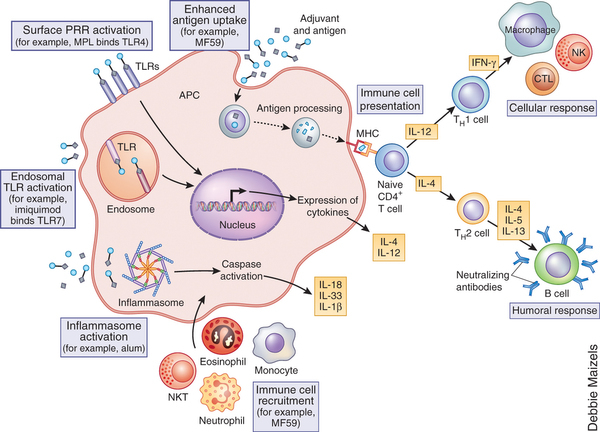FA16 Immunization Module’s Updates
Adjuvants in Vaccines
This may be a less detailed version of @Angela Kim’s comment, so one can refer to that for more detail on cytokines and receptors used in the adjuvant triggered response. I thought the above diagragm was very useful for putting the process together.
Adjuvants are substances that are coadministered with antigens in vaccines in order to activate antigen-presenting cells. They function by stimulating the APC to secrete cytokines to activate helper T cells. Without this coactivation, the antigens used in vaccines would be unable to elicit T-cell dependent responses.
Adjuvants can be products of microbes or microbe-like substances, which bind to Toll-like and Nod-like receptors in the APC. This causes the expression of B7 molecules, which can be recognized by the T cell CD28 receptor to provide signal 2. The APC can present these adjuvants to the T cells to help with B cell proliferation.
The adjuvants that we currently use in the United States are aluminum salts, like aluminum hydroxide, aluminum phosphate, and aluminum potassium sulfate, and monophosphoryl lipid A. These have been used since the 1930s. Aluminum is used for the childhood vaccines for hepatitis A, hepatitis B, diphtheria-tetanus-pertussis (DTaP, Tdap), Haemophilus influenzae type b (Hib), human papillomavirus (HPV) and pneumococcus infection and monophosphoryl lipid A is used in the HPV vaccine. However, measles, mumps, rubella, chickenpox, rotavirus, polio, and seasonal influenza vaccines do not contain added adjuvants.
Sources:
http://www.fda.gov/biologicsbloodvaccines/safetyavailability/vaccinesafety/ucm187810.htm
http://www.cdc.gov/vaccinesafety/concerns/adjuvants.html
Basic Immunology: Functions and Disorders of the Immune System, 5th Edition, Pg 111



@Callum & @Mohammed I think Dr. Tapping mentioned another type of adjuvant specifically used in Europe in the H1N1 flu vaccine.
Two European adjuvants are mentioned in the PowerPoint -- monophosphoryl lipid A, and MF59; however, no comments are made on the efficacy of either.
Thanks for the detailed description of how adjuvants are used to make vaccines more effective. Are there any known side affects to the common adjuvants used in the U.S., and how do they differ from the main ones used around the country? Also, what are the main reasons an adjuvant is used in conjugation with a vaccine?
Future Dr. Dewar, first, let me say that your post was as informational as it was a pleasure to read. Second, I would just like to inquire if there are other more effective adjuvants than the ones listed? Otherwise, do the listed adjuvants such as aluminum salts, and aluminum hydroxide have properties that lead to a more rigorous triggered response?